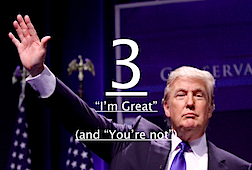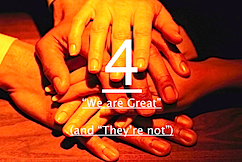Tribal Leadership – improving your business culture part II
…this blog is a continuation to the Tribal Leadership series in rework365.com. The previous article about the stages 1 and 2 can be found here: “Tribal Leadership – improving your business culture part I“. This part describes the tribal stages 3 and 4. It makes sense to discuss these two stages at the same time because the leap from stage 3 to stage 4 has the biggest potential for improving your result i.e. your bottom line. So, pay attention and think a little bit on which stage you or your team could be. But: be honest, most of the people rank themselves (as an individual or team) half or one stage higher than they really are.
+ + +
Stage 3: “I am great (and you are not)”

The tribal leadership stage 3 can be described with one sentence (or way of thinking if you will). This sentence is “I am great” and the unspoken part of it “…and you are not.” This may sound harsh and in a way it is harsh. People at stage 3 focus on their own success, their own goals, their own agendas and often they are very keen on climbing higher on the career ladder. Political games thrive, but people feel generally motivated and they have “drive”. On the other hand people can feel that someone else (usually external power beyond their control) is preventing them being even better. This “force” could be budget, difficult customers, company pricing policy, resource allocation or simply other employees or departments. Often the stage 3 “culture individualism” is strongly supported by the financial incentive structure as well as by social factors such as showing public respect to people who are successful. In plain english this means paying bonus based on individual performance rather than performance of the team or whole company.
People on the stage 3 tend to build relationships between two persons, so called dyads. In dyads the communication happens between two persons. Working dyads require a lot of time and effort. This is simply because you end up talking the same story over and over again to many people – one at the time. You can be seen as a “gatekeeper” as hardly anyone gets the information without talking to you. Dyads are bottlenecks of information flow and absolutely deadly to team working. The stage 3 managers, however, do not always form dyads purely because of political or career reasons. Many manager simply feel that they are obliged to help people out in all tasks. They see that it is the reason why they are managers and fall into the endless micro management trap.
People at the stage 3 tend to say thing like “I was meeting customers and closing sales while you where sitting in internal meetings”, “They gave ME this opportunity”, “I am leading MY team” or “I told MY employees to…”. I guess you get the point by now. The common sign of the stage 3 culture is “ME, I and MY” language. This leads easily to self promotion (and pushing others down) instead of focusing on the subject itself.
Stage 3 is the most common tribal cultural level representing 48% of the businesses. (Source: Tribal Leadership/Dave Logan & co). Being the most common culture, the stage 3 can be found in all areas of business.
+ + +
Stage 4: “We are great (and they are not)”

The tribal stage 4 can be described with one sentence (or way of thinking if you will). This sentence is “We are great” and the unspoken part of it “…and they are not.” People at stage 3 are truly proud of their work and achievements as a team. The highest goal is the performance and goal achievement as a team. Often (but not always) the financial incentives are built around team achievement.
The unspoken part of the stage 4 culture is “and they are not.” Who are “they” actually? At stage 4 “they” can be understood as competing businesses and also as other departments inside the company. One of the most common examples of the rivals inside a company are marketing and sales. That is, in the companies where marketing and sales are separate departments.
The characteristic of the stage 4 relationships are triads. Triads are relationships formed by three people. Let’s make an example. You are the boss and one of the team members comes to you and tells there is a problem between him and another team member. How would a stage 3 boss react? He would probably say “Thanks for telling me that. I will look into it and talk to her (the other team member)”. By doing this he would for two dyad relationship, he being the “gatekeeper” in the middle. How would stage 4 boss react? He would probably say something like this “OK, I see. Let’s go and talk to her”. Then he would bring all three (himself and the two team members) to the same discussion. He would explain them that they are the experts on this issue and they should find a solution together, without his intervention. This is one example what building triads mean.
People and businesses on the tribal level 4 are strongly driven by their values. This is their own values, what they feel is valuable for them. It is often mixed with the, unfortunately so common, company values defined solely by the management. The fact is that the people live their own values regardless what management decides. Key to success is to define the company values by asking the people what is important to them and further developing the answers the company values.
Stage 4 represents 22% of the businesses. (Source: Tribal Leadership/Dave Logan & co). The stage 4 can be found in all areas of business, however it is very seldom for example in governmental structures and politics.
+ + +
In the coming blogs I am going to introduce you to the stage 5 and it’s characteristics in detail. After that I am going to give you tips how to help your company culture to advance to higher levels.
STAY TUNED!
TO BE CONTINUED!
+ + +

Thank you for these blogs, Juhana.
I am commenting on your bio: “People who are committed to maintain yesterday are not able create tomorrow.”
I have a client in the archiving world. In fact, this client collects the history of the gay and lesbian movement in the Netherlands, and also has a European focus. There are many gay and lesbian community organisations worldwide doing this and for one main reason: if they don’t collect (maintain) their history, the gains they have made as a movement in the past 60 years could be blown away. By collecting the past they inform the present and inspire the future. Gay rights activists today can look back in the archives and discover whose steps they are walking in.
Keeping track of the past is not just relevant for human rights activists. One of the first things every new power after defeating a ruling foe is to destroy the old archives. Idi Amin did this in Uganda – but even the English did it when they claimed New York from the Dutch. When the archive disappears, so does all knowledge of the past. Ugandan students of history have to study in England, because the colonists of Uganda (until they were usurped in the 1960s) kept an archive.
And on a completely different tack, when I moved into my new home, the previous owner gave me a set of all information relating to appliances they had installed. Imagine where I would be if the boiler broke down and I had no idea where it came from and who installed it.
So I say that people who preserve the past are part of the group that inspires the future.
You are welcome! Thank you for the great comment Lin!
You have a good point there. As a matter of fact also many of the new innovations are often based on the past happenings and on information how people do and did things. As well in (orgnizational) culture change it is often very helpful to understand the history of people. So you are absolutely right, understanding and knowing what has happened is absolutely necessary and sometimes crucial for success. What I mean in my bio by “maintaining yesterday” is rather the obsessive resistance of changing things and inventing something new by hanging in the past and not being able to see “what could be possible”.